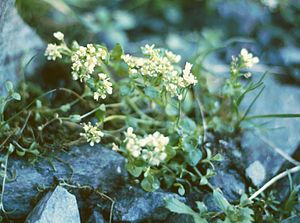Alpine spoonwort
| Alpine spoonwort | ||||||||||||
|---|---|---|---|---|---|---|---|---|---|---|---|---|

Alpine spoonwort ( Cochlearia excelsa ) |
||||||||||||
| Systematics | ||||||||||||
|
||||||||||||
| Scientific name | ||||||||||||
| Cochlearia excelsa | ||||||||||||
| J.Zahlbr. ex Fritsch |
The alpine spoonweed ( Cochlearia excelsa ) is a plant species from the cruciferous family (Brassicaceae) that only occurs in the Austrian central Alps .
features
The alpine spoonwort is a two-year to perennial hemicryptophyte . According to Staudinger, it is a hapaxanthe , evergreen semi-rosette shrub. It becomes 5 to 10 cm high, the flowering plant rarely up to 17 cm. The rhizome is 4 to 8, rarely 10 cm long, the side roots are not noticeably dense. The basal leaves are kidney-shaped, 0.5 to 1.4 cm long and 0.5 to 1.9 cm wide. The leaf base is often very heart-shaped.
The yellowish-white flowers are in clusters. The fruit stalks are once or twice as long as the fruit and are at an angle of 40 to 60 ° from the fruit axis. The fruits are broadly ellipsoidal to obovate, the largest fruits are 3 to 5 (rarely 6.4) mm long. The seeds are 1.3 to 1.7 mm long. Flowering time is July and August.
The chromosome number is 2n = 2x = 12, the species is diploid .
Distribution and locations
The species is endemic to the Austrian Central Alps. There are only three areas of discovery: in the Gurktal Alps on the northern slopes of Eisenhut and Wintertaler Nock on both sides of the Carinthian-Styrian border and 80 km away in the Seckau Alps with several populations, a large one on the Zinkenschütt.
The locations are at the alpine altitude between 2000 and 2360 meters above the Adriatic Sea . The plants grow in swollen and wet places, especially in overflowing, mossy rock and stone corridors. The species avoids lime and occurs only over slate and gneiss.
Hazard and protection
The alpine spoonbill is classified as potentially endangered due to the few known populations and the small area. The locations in the alpine zone are difficult to access and therefore relatively safe from human influence. A threat to the species comes from the effects of global warming.
Systematics
The plant is a diploid representative of the clan group around Cochlearia pyrenaica . The species were split into several, partly polyploid, species during the last ice ages. Cochlearia excelsa is a relic endemic that may have survived the Ice Age in the non-glaciated Gurktal Alps near its current locations. It is not closely related to the ecologically very similar species Cochlearia tatrae in the High Tatras. Their closest relatives are probably the diploid Pyrenean spoonweed ( Cochlearia pyrenaica ) and the diploid thick-root spoonbill ( Cochlearia macrorrhiza ).
supporting documents
- Manfred A. Fischer , Karl Oswald, Wolfgang Adler: Excursion flora for Austria, Liechtenstein and South Tyrol. 3rd, improved edition. State of Upper Austria, Biology Center of the Upper Austrian State Museums, Linz 2008, ISBN 978-3-85474-187-9 .
- M. Staudinger: Cochlearia excelsa. In: Wolfgang Rabitsch, Franz Essl: Endemites - Treasures in Austria's flora and fauna . Natural Science Association for Carinthia and the Federal Environment Agency, Klagenfurt and Vienna 2009. ISBN 978-3-85328-049-2 , p. 109f.
Individual evidence
- ^ M. Staudinger: Cochlearia excelsa. In: Wolfgang Rabitsch, Franz Essl: Endemiten - Valuables in Austria's flora and fauna , 2009.